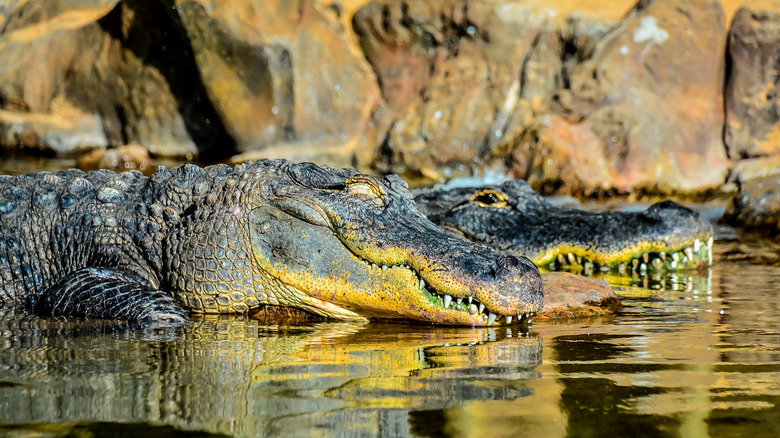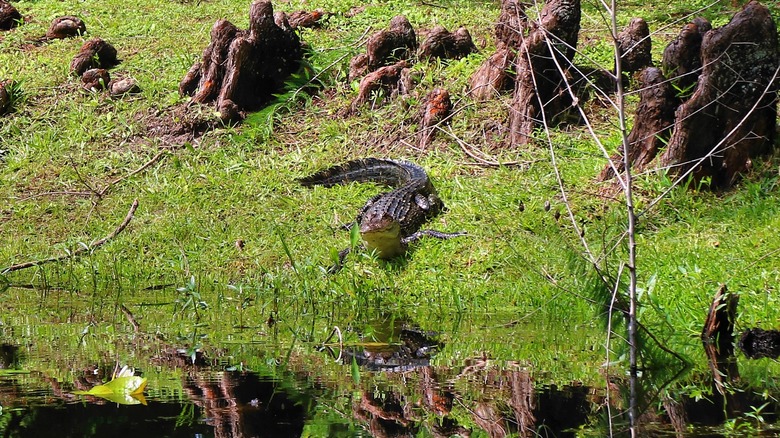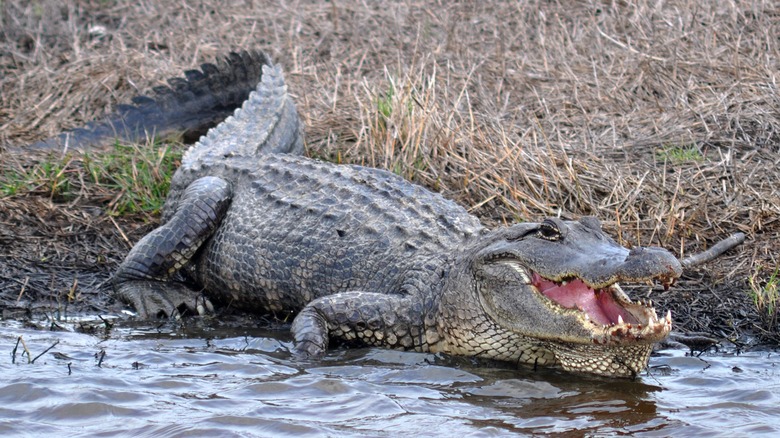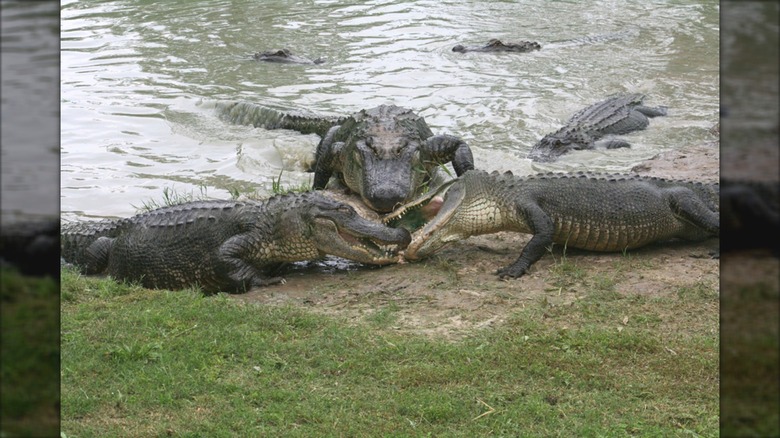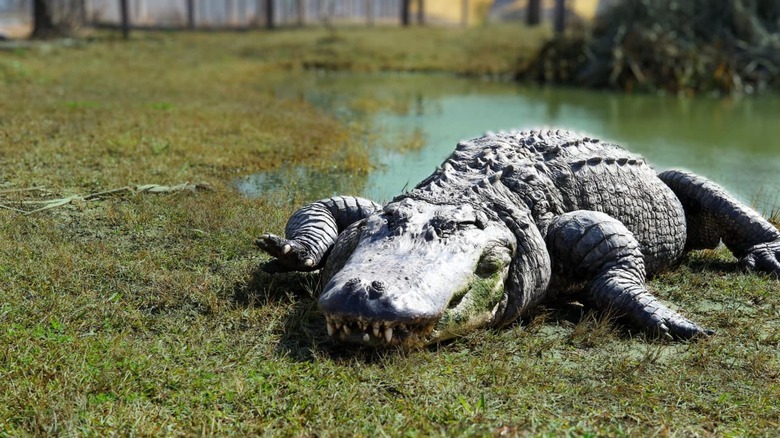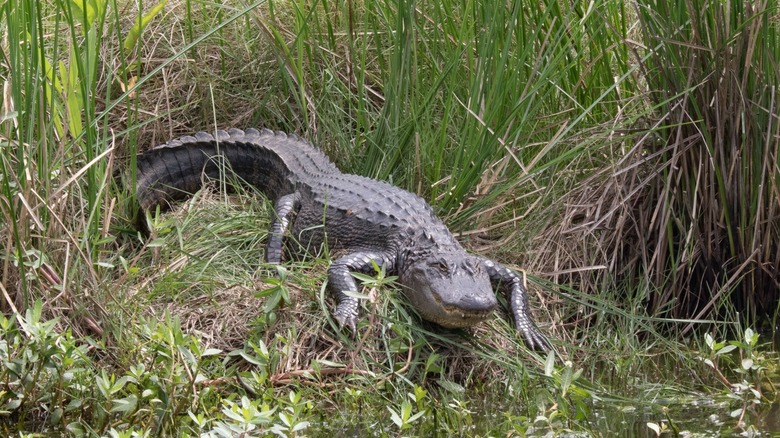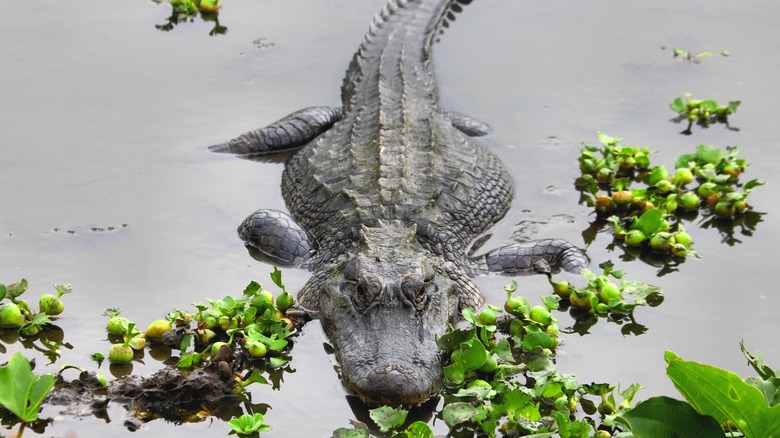6 Best Places To See Alligators In Texas On Your Vacation
More than just appealing creatures to watch, reptiles are important to humans because of their ecological roles as predators and prey in the food chain. One of the most intriguing of these animals is the alligator, with people traveling to far-flung places to get a glimpse of the creatures. Texas is one state that gets a lot of alligator tourism because it has a population of around 400,000 gators within its borders. If you plan to visit the Lone Star State, learning about the reptile's preferred habitat is a good place to start.
There are two different types of alligators, but the American alligator (Alligator mississippiensis) is native to the Southeast, and Texas has the third highest population. Previously an endangered species, this reptile prefers canals, lakes, marshes, rivers, and swamps with slow-moving, freshwater ecosystems. These areas are mostly around the eastern third of the Lone Star State, which has special hunting restrictions to protect these animals. Let's take a look at spots where you're likely to see alligators, as well as one where you're guaranteed to see one.
Caddo Lake State Park
Caddo Lake State Park in Karnack, Texas, is known for its bald cypress trees, which are draped with Spanish moss and stand tall over Big Cypress Bayou. Caddo Lake is special because it was Texas' only natural lake (it was dammed in 1914), and Caddo Nation legend has it that the lake formed after a giant flood. According to scientists, that's not too far from the truth. Floodwaters that were blocked by a huge logjam on the Red River eventually broke through to the Cypress Bayou watershed, creating the lake in the 1800s.
The area is so lush that most of the lake and park is a maze of bayous, ponds, and swamps, making it an ideal habitat for alligators. In fact, visitors have found massive gators here measuring more than 13 feet and weighing a whopping 900 pounds. That doesn't compare to the 20-foot creature of legend that makes some people afraid to swim in Caddo Lake (and we don't blame them). Aside from gators, the 26,810-acre environment is home to a variety of other wetland plants and animals like lily pads, American lotus, frogs, and turtles. During vacation time, visitors are welcome to an array of recreational activities, from paddle boating and fishing (particularly bass and crappie) to camping and hiking.
Lake Livingston State Park
Lake Livingston provides water to Houston and other cities on the eastern side of the state as one of the biggest reservoirs in Texas. The surrounding Lake Livingston State Park is considered a piney, lakeside retreat for families and has a rich cultural and natural history. Established by the Texas Parks & Wildlife Department in 1977, the 635-acre park was first home to Paleo-Indians about 12,000 years ago, and 2,200-year-old pottery indicates that they were growing squash, beans, and corn. While the original hunter-gatherers are long gone, the Alabama-Coushatta Tribe of Texas still lives on the area's tribal lands, although they aren't the only inhabitants.
Lake Livingston State Park is located along the East Texas Timber Belt and Post Oak Savannah lowlands. It experiences mild temperatures, and gets almost 50 inches of rain each year. Together, these features create a fantastic habitat for all kinds of flora and fauna, including alligators. Boaters on the lake have reported having close encounters with reptiles that are bigger than their water vessels — One family of three estimated that a gator they saw was about 16 feet. Some of these massive beasts even stray from the lake a little and block traffic on nearby roads.
Along with spotting these reptiles, many visitors enjoy birdwatching, boating, and fishing, particularly bass, catfish, crappie, and perch. Swimming is also allowed in designated areas, and it's important to stick to these designated areas for obvious safety reasons.
Big Thicket National Preserve
If you've ever wondered where bogs are located and want to visit one, Big Thicket National Preserve is one of several in South Central Texas. This bog is home to a longleaf pine forest and bald cypress trees that stretch across 113,114 acres within the roughly 3.5-million-acre Big Thicket region. Despite archeological efforts, researchers don't know much about the original inhabitants. What is known is that multiple tribes made the region their home, and the Alabama-Coushatta Tribe of Texas continues living on an adjacent reservation.
Big Thicket National Preserve was established in 1974 to protect its vital ecosystem from an industrial boom — mainly oil and gas extraction and logging. Receiving an average of 55 inches of rain every year, the bog is home to about 1,320 known plant species, three of which are endangered. It's home to a range of birds, mammals, mollusks, and reptiles, including alligators, anoles, snakes, and turtles. Within the preserve, visitors have reported seeing gators along Neches Lake, Scatterman Lake, and Village Creek. These aren't the only possible sighting spots, but they are particularly great for paddle boating. Although very few confrontations between alligators and humans have occurred in the park, visitors should always take safety precautions.
Gator Country
Located in Beaumont, Texas, Gator Country is Southern Texas' biggest sanctuary and adventure park featuring alligators. It's actually home to more than 450 animals, including crocodiles, other reptiles, and some mammals. More interesting is that 90% of these animals were either given up, surrendered, or rescued, and Gator Country gives them a caring home while allowing visitors to mingle with them. Actually, this is where you go to see the largest captive gator in the country — Big Tex, who measures 13 feet, 11 inches. Legendary Big Al is no slouch, though, at over 90 years old and 13 feet, 4 inches, he's the second-largest captive gator. The gators perform in the pond for guests, under the handlers' instructions, of course.
Gator Country is one of few places where you can pick up and wade in the water with juvenile alligators, as well as interact with the other reptiles and mammals in the petting zoo. Adding to the entire experience, it offers swamp boat tours across Taylor Bayou. These small outings offer a private way to learn about the alligator habitat in Texas, during which you will hear from experts about the ecological importance of the local ecosystem of wetlands and the abundance of species that live there. Along with the possibility of seeing alligators in their natural habitat, the boat tours are a great way to see other wildlife, including ducks, herons, owls, and woodpeckers.
Jocelyn Nungaray National Wildlife Refuge
The Jocelyn Nungaray National Wildlife Refuge is a 34,000-acre sanctuary for an abundance of wildlife. The refuge was formerly called the Anahuac National Wildlife Refuge. The word "anáhuac" means "watery plain" in the Náhuatl language of the Aztecs, but the land was never connected to the Aztecs or their distant relations. Instead, the area was part of the nomadic Atakapa and Akokisa people who left behind campsites and middens, or piles, of shellfish.
Located in Anahuac — known as the Alligator Capital of Texas and for hosting Gatorfest at Fort Anahuac Park in celebration of all things gator — this refuge is part of a larger chain of wildlife sanctuaries along the coasts of Texas and Louisiana. The wetland and bottomland hardwood forest is full of hackberry, oak, pine, and sweetgum, which drink from an average 51 inches of rainfall a year. Among the variety of wildlife living here, alligators have a rather large population.
You're almost guaranteed to see some while driving the 2.6-mile Shoveler Pond Auto Tour Loop, which has a boardwalk and overlook. The gators are often basking in the sun along the edge of the water, sometimes even resting their heads on turtles rather than eating them. It's important, though, to keep a safe distance along the loop and boardwalk, as well as while fishing. In fact, the Chambers County Sheriff's Office reported successfully rescuing a man in May 2024 after he was chased up a tree by an alligator while he was fishing.
Brazos Bend State Park
Covering about 5,000 acres, Brazos Bend State Park is home to thousands of plant and animal species, and it has an interesting history. It was the site of the first colonial land grant from Mexico in the early 19th century. After the Texas Revolution, the riverfront was sold, and part it and the park was held by Brazoria County cotton brokers. The real attraction here is the nature, though — including plants and animals that live in lakes. Opened in 1984, Brazos Bend State Park protects three ecosystems, which you can learn about from exhibits at its nature center. More than 25 species of mammals (like bobcats, feral pigs, and river otters) and 21 species of amphibians and reptiles live here.
The park has about 250 or more gators that are 6 feet and longer, but it's estimated that there are thousands of gators smaller than that around its 1,000 acres of water. These alpha predators have lived in the area for at least 65 million years, but the best places to look for them today are along the edges of 40-Acre Lake and Elm Lake because these are the biggest bodies of water (as well as ideal fishing spots for bass, catfish, crappie, and sunfish). Also, the gators can be seen along the park's walking paths, so watch your step. You can learn more about the alligators and wildlife at the Brazos Bend State Park Nature Center.
